Portfolio Anthony Robbins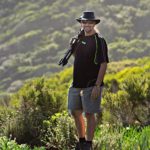
Dit aanstormende talent laat in OOG VOOR AFRIKA 02-2017 zijn mooiste wildlife foto’s zien. Hieronder vind je per foto een bijzondere beschrijving. Ga mee in de wondere wereld van wildlife fotograaf Anthony Robbins.
Big Orange
- (Where) – Taken on the small, but very special, Mabula Game Reserve in the Limpopo Province of South Africa. We worked on this 12000 hectare game reserve for 6 years and without a doubt it truly is a special place. Ok, the animals are fairly habituated to the vehicles and sometimes this seems unnatural but it does allow you great opportunities to get up close to the animals. Then there is the species list, never have I worked on such a small game reserve with so much diversity, I mean where do you get to see Aardvark and Aardwolf together at one sighting!
- (How) – Due to the time and light the photo of “Big Orange” was taken, as well as the fact that I was not truly prepared for taking photos at night, I had to do with what I had, often the case in many wildlife photography situations. No camera support available, no flash (admittedly I did at least have a spotlight and my wonderful wife to hold the spot light where I needed it). Camera set to “Manual” mode I needed to be able to hand-hold my Canon 1D MK3 and 400mm f5.6 prime lens, which I set on camera to f7.1 (I find this particular lens best at this setting) and push my cameras ISO limits to 3200. This gave me a “whopping” 1/60 Shutter Speed and I needed to be as steady as a rock.
- “Big Orange” has always been one of those photos which I will remember taking. Spending time in the African bush has taught me many things and normally birds will fly away from you but when they don’t then you need to take the opportunity and use it to the best. This White-Faced owl was very happy to sit and have its photo taken, time and time again. This of course does help when pushing your camera and your own personal “steadiness” to the complete max. I was able to take various photos, moving the light source around,
 meaning instructing my wife to move and supply light from another angle….she is good that way, and “Big Orange” did every now and then give me a different composition but in the end this one I liked best. I guess what I am trying to say is simply there is always a way to work around your situation. Yes cameras have limitations, lens’s have limitations we as photographers have limitations but if you don’t try you will never know. So try, and if you fail, try again. There is a “Big Orange” out there for us all waiting in a tree somewhere, go and find it and push your limits.
meaning instructing my wife to move and supply light from another angle….she is good that way, and “Big Orange” did every now and then give me a different composition but in the end this one I liked best. I guess what I am trying to say is simply there is always a way to work around your situation. Yes cameras have limitations, lens’s have limitations we as photographers have limitations but if you don’t try you will never know. So try, and if you fail, try again. There is a “Big Orange” out there for us all waiting in a tree somewhere, go and find it and push your limits.
Dusty Trunk
- (Where) The far Northern areas of Botswana offer amazing areas for wildlife and the Linyanti swamps are one of those areas. We had the privilege of working in this area of Botswana and
 when you looking for “Wild” this is it. The dry months are best to visit this area as the lack of water means the animals all need to eventually go down to the remaining ponds and drink.
when you looking for “Wild” this is it. The dry months are best to visit this area as the lack of water means the animals all need to eventually go down to the remaining ponds and drink. - (How) Taking photos into the light can be tricky sometimes, lens flare, too much light, not enough light and then there is always the risk of doing damage to the camera or lens but the results can look amazing when you get it right. I love taking photos into the sun, getting the silhouettes and then the colours you can achieve. I have taken many photos like this and therefore have a preset in my head that I will always adjust my camera to and then work from there. Low ISO for me is the key, drop your ISO low. Here I set my camera’s ISO to 100, because you shooting into the sun there is always enough light and you should find that your Shutter Speed will be way more than enough, 1/2500. Aperture set to f8 and my Exposure Value (EV) set to -2/3, I want the dark silhouettes.
- As mentioned I love to take photos like this. I like a challenge and although it might not be the greatest challenge you will ever face taking photos of wildlife it still keeps you on your toes and teaches you to think and try new things. I always try and have my camera with me when we out with guests, you never know but I also try and get out on my own and this was one such day. As the sun was setting we made our way to the water hole, parked up where we want to be making sure not to be in the way of the herds of elephants that would join us soon and waited. Hundreds, no wait thousands of elephants make their way down late afternoon to come drink and if you not in their way the sightings are truly amazing. This particular type of photo with elephants in the sunset are a dime a dozen and therefore you need to think a little. I had parked the vehicle out of the elephants way but I also parked the vehicle so that the slight breeze blowing would waft my manly bush smell towards them. Knowing animal behaviour helps and elephants love to lift their trunks when smelling the air, obviously positioning the vehicle in such a manner helped to achieve this, either that or it was simply my manly bush smell. Get to know your subject is a term often used in the photography World and wildlife photography is no different. Yes working in the bush for many years has helped me but simply stopping and observing what is happening can help you achieve that different photo you want.
Fish Eagles
- (Where) The Kruger National Park, South Africa. One of my, no wait, my top wildlife destination for various reasons. I love the place, so much so that I got married there. I have been
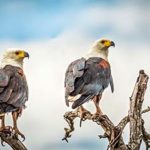 fortunate to work in the great reserve doing game drives with guests from all walks of life and I think that is what makes it such a great place. Whether you Rock-a-Fella or The-Other-Fella the Kruger National Park offers accommodation for all, from the glamorous private lodges right down to camping, it is there. Yes, the roads and sightings can get busy but I have never been anywhere else where I can see so much variation of wildlife.
fortunate to work in the great reserve doing game drives with guests from all walks of life and I think that is what makes it such a great place. Whether you Rock-a-Fella or The-Other-Fella the Kruger National Park offers accommodation for all, from the glamorous private lodges right down to camping, it is there. Yes, the roads and sightings can get busy but I have never been anywhere else where I can see so much variation of wildlife. - (How) I love to take photos of birds, especially birds in flight and it was my main reason for purchasing the lens I use today, it’s simple, nothing fancy, a Canon 400mm f5.6. Light in weight and easy to move around. Of course we all want the big lenses but have you ever seen or tried to use a big 600mm lens from the window of your vehicle, funny as hell watching people adjusting themselves so that they can try and get a photo while sitting on their wives lap in the passenger seat, lens sticking out the driver side window. When taking photos of birds perched on a branch I always try and make sure that my ISO (here set to 400) is high enough to give me a fast Shutter Speed, here 1/3200 and Aperture f7.1 (my lens’s sweet spot), so that if the bird does fly away I am able to get it in flight.
- A moment, sometimes you get to see amazing things in the African bush and everyone will always tell you the call of the African Fish Eagle is the African call, we all know it. It is not an unfamiliar sight to see a Fish Eagle in the trees but it is rare to see two sat side by side and of course if the door opens, walk through. Yes, I will be the first to admit that there are better photos out there of Fish Eagles but sometimes you need to remember why you are in the bush in the first place and why you want to take that photo, how many times do you see such a sighting, remember it, share it with others. I mean is that not why we take photos in the first place.
Grimm
- (Where) Kruger National Park, South Africa…..again. Yip, as mentioned before it is without a doubt a great place for wildlife. This time I was far up north of the Kruger Park around an area
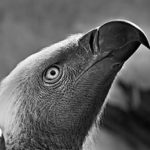 known as Shingwedzi. Well known for its elephants and bird life because of amount of water around the area, if you like birds the North of the Kruger is the place.
known as Shingwedzi. Well known for its elephants and bird life because of amount of water around the area, if you like birds the North of the Kruger is the place. - (How) With the vulture really close to me and not moving around too much and using a Canon 70mm – 200mm f4 lens I was able to setup for the best possible quality. Setting my ISO to 100 (as little graining as possible) and Aperture to f6.3, this gave me a Shutter Speed of 1/400, fast enough to hand hold and get the photo I wanted, always try and have your Shutter Speed 2x faster than your lenses focal distance (lens 200mm and SS 400). I often shoot in Aperture Priority so that I can control the Depth-Of-Field and this is a prime example of wanting the vulture’s eye and head in focus but the rest blurry.
- A person can spend a lot of time driving around game reserves between sightings but when I do get to an interesting sighting I like to sit for a long time, watching the animals behaviour and learning what they do and how they act. However, I have to say that this was one sighting I really did not want to sit around for too long. The day before, late afternoon, I heard people at the camp site talking about an elephant that had been killed by two large male lions. Of course I would have loved to have been there to have seen that but that is how things go. Many years in the bush have taught me that by the next day there would still be a lot of activity going on around the carcass, possibly even the lion would still be around. So early the next morning, we got up and headed off to find the carcass. We found it alright, impossible to miss unless you had no sense of smell. The elephant carcass lay not 10m from the road side. I positioned the vehicle for the best angle and turned off the vehicle. Now who says taking photos in the wild is glamorous? Mother Nature decided to test our stomachs and boy did she? A light breeze picked up and the smell of the carcass was sent in our direction. I am one of the lucky ones who has worked on many animals dead and alive and over time have kind of worked up a bit of a stomach for this but today I was super pleased I had not yet eaten breakfast. But once past the nose burning, stomach wrenching smell I was able to get some great photos from the sighting. No lions unfortunately but the vultures and other scavengers were all around us and after an hour or so had become accustomed to the vehicle which allowed me to get so close to them. So if you have the stomach for it spend the time at sightings no matter what it smells like. The rewards will be worth it in the end. Oh, and a tip, any menthol smelling cream positioned on your top lip helps with nasty smells.
I Don’t Get It!
- (Where) The Mopani area of the Kruger National Park, South Africa is my personal favourite area throughout the entire Park. Many people don’t like this area and there is a good reason for
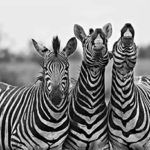 it. When you drive the main road through this area, all a person sees is Mopani trees. Short, bushes everywhere, and not much feeds on them, although elephants love them. However, spend time in the area and drive through the Mopani thickets and you come out into huge open areas of nothing. The wildlife in these open areas are amazing and most of the open areas have waterholes and we all know water is life in the African bush. I spend many hours just sitting in my vehicle watching the wildlife move in and out of the open areas to come drink.
it. When you drive the main road through this area, all a person sees is Mopani trees. Short, bushes everywhere, and not much feeds on them, although elephants love them. However, spend time in the area and drive through the Mopani thickets and you come out into huge open areas of nothing. The wildlife in these open areas are amazing and most of the open areas have waterholes and we all know water is life in the African bush. I spend many hours just sitting in my vehicle watching the wildlife move in and out of the open areas to come drink. - (How) Taking into account that the rain was falling and the light was bad, no excuse for not taking photos or trying out different things with your camera, I needed to let set my ISO high enough, 1000, in order for me to have a fast enough Shutter Speed to deal with not only the light conditions but also the fact that I was watching the zebras running around. Shutter Speed at 1/500, Aperture set to f8 and using my trusty Canon 400mm f5.6 lens only this time I had a converter on giving a focal distance of 560mm.
- Spending time watching animals do what they do is for me probably the most important advice I could ever give anyone when it comes to wildlife photography. No matter where you are or what the conditions are like, spend time with them, not only will you learn their behaviour but the animals will become habituated to you and eventually pay you little or no attention at all. These three stallions were running around, rolling and play fighting with each other for a good hour and of course I had taken many photos of them. Trying out motion blur photos as they run past, slowing the SS down and practising. They had just finished rolling around in the water when they all three stood up and looked straight at me. Two of them sniffed the air in what is known as flehmen, many animals do this and the way zebras do it is to lift their lips and show their teeth. Of course I took the photo but with my sense of humour bust out into laughter….I Don’t Get It! I never really name my photos but this one I just had to, for me it seemed as if someone had told a joke and only two of them really got the joke, the third, well maybe he is the slow one in the group.
Mothers Protection
- (Where) Etosha, Namibia. Fast becoming a big favourite of mine to visit for many reasons. The wide open spaces, the true survival of the fittest and the variety of animals you get to see. It
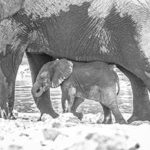 truly is a must see.
truly is a must see. - (How) With my camera, Canon 1D MK 3 and lens, 400mm f5.6 supported (Bean bags work great for this as well as the fact that you can transport them empty and fill them when you arrive at your destination) on the side of the car. I setup my camera for some slow moving subjects. Let’s be honest, elephants don’t really move to fast and therefore you can afford to slow things down a little, Shutter Speed set to 1/250, Aperture to f7.1 so that I can have a good Depth-Of-Field, and ISO set to 400. So here is something important to remember, try and visualise what you want your end result to look like. I knew I wanted this photo in black and white and I also knew how I wanted the final result to look like and therefore I adjusted my Exposure Value (EV) to +1 1/3. By doing this it over exposed my photo, not by much but enough to give me more detail in the shadow areas and also to, let’s call it blend, the foreground whites.
- As mentioned before and many more times, water is the key. Where ever there is water there is life. Animals can survive without food for long periods but simply without water, nothing will survive. Often when elephants come down to drink there is a process, they normally rush in, drink and once have had their fill they will either up and leave or they will stick around. If they hang about the chances are they will start to play in the water or mud themselves so of course this is great entertainment. When this playing starts, mothers with young calves will often keep them close by so that the playful teenagers don’t hurt them accidently. I love the framing of this photo, I would of course…..maybe a little biased towards my own photo, but the fact that the baby is totally protected by mom’s frame just shows you how these amazing animals care for their young.
Sand In My Eyes
- (Where) Eastern Cape, South Africa. The small rural town of Hamburg is a little hidden gem. Many of these small villages along the coast of Southern Africa provide great destinations but
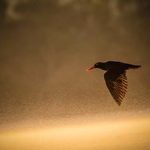 very few people know of them, especially people from overseas coming out on holiday. Instead of the crowded beaches of other major holiday destinations these small rural villages provide you beaches with not another person one them, bliss!
very few people know of them, especially people from overseas coming out on holiday. Instead of the crowded beaches of other major holiday destinations these small rural villages provide you beaches with not another person one them, bliss! - (How) I love taking photos of birds in flight and it is probably the main reason I own the lens I do, Canon 400m f5.6. This lens is light and easy to hand hold. Yes it is not the greatest lens out there on the market but I have seen artist paint masterpieces with broken brushes. Set at f5.6 and ISO to 200 my Shutter Speed at 1/400 I am able to use this combination of equipment with ease.
- Oyster Catchers are one of the bird species I love. With their bright orange eyes and bill and totally black wings and body just is such a contrast. They are one of the bird species which are in danger in Southern Africa and to see them and get the chance to photograph them is something special. Spending time with them and allowing them to adjust to you being in their environment will always pay off. Here, this Oyster Catcher got inquisitive of me and started to fly around me, of course like most places along the eastern coast of Southern Africa the wind blows and this help add a story to the photo. I truly don’t know who actually got more sand in their eyes, the Oyster Catchers or me. Personally, I think me. A tip for when photography along the windy coast, use a refuse bag and tape it over your equipment to prevent small fine sand particles getting into your lens or camera.
Sisters
- (Where) Linyanti, Botswana. As the water dries up around other areas of Botswana, the Linyanti swamps keep the water for a longer time. This of course attracts the plains game to the water
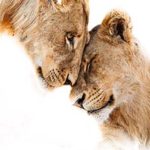 and with them so too do the predators follow.
and with them so too do the predators follow. - (How) A slightly overcast day often turns people away from taking photos. However I always say, try something different, experiment with settings and play. Here I wanted to achieve that “High Key” look to my photo, yes a lot was done in processing but by overexposing I already burnt out a lot of the background to white so actually very little needed to be done come processing. I am a firm believer that you should try and achieve what you want in the camera and therefore reducing the amount needed to be done in processing. ISO set to 640, Shutter Speed to 1/800 and aperture to f5.6. Using my 400mm lens and doubling the SS allows me to hand hold is necessary.
- Watching Lions can be one of the most boring sightings in the wild. Most of the time they just simply lay under a tree in the shade and that’s it. Of course there are the times when they get up and go hunting but those a far and few between. They do however have to get up and move out of the sun eventually. So again, spend time at the sightings, take note of what is happening. Lions hate getting hot and if they only just in the shade and the shifting, they will get up and move to a more shady area. Sometimes, like all cats, they will interact with the rest of the pride during this moving about. Be it playing, biting, eating or simply a head rub between sisters.
Stormy River
- (Where) Storms River Valley, Eastern and Western Cape, South Africa. Shhhhh…….. don’t tell anyone. For some reason this area of South Africa is hardly visited by tourist but is truly the
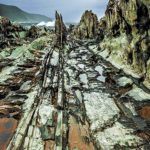 most beautiful. The Knysna forest, big mountains, blue oceans and amazing scenery. A hidden treasure when it comes to landscape photography.
most beautiful. The Knysna forest, big mountains, blue oceans and amazing scenery. A hidden treasure when it comes to landscape photography. - Setting up for landscape photography is time consuming, tripods, weights, filters, shutter release cables, the whole bang shoot. It is an effort but always worth it. Trusty Canon 1D MK 3 in hand, ISO as low as possible 50, Aperture set to have as much in focus as possible f22 and Shutter Speed set to 1/6 so that I can achieve movement of the waves in the background. All setup on my tripod which is weighted down so to reduce any movement caused by the coastal winds. A shutter release cable, again to reduce any movement you may cause when pressing down on the camera. Oh and my lens, HA….you will laugh but I believe use what you have and take you photo rather than wait till one day when you own a better lens, by then the idea and photo is long gone out of your mind or perhaps you might never visit there again, who knows. My trusty Canon 24mm-90mm kit lens that came with an old camera of mine many many many moons ago. It is missing buttons but it still works and it is all I have so I use it, one day I hope to improve on this lens but for now I make the best of what I have.
- Storms River mouth is a nature reserve along the coast offering you an area to walk along a see some of the most amazing sights. The waves crash on the rocks and the opportunities are endless. I am the adventurous type and therefore often find myself in places others might not venture to. Here the tide had pulled out and the waves no longer crashing down so I decided to walk over the sharp jagged rocks to find some interesting views. I liked the way the higher rocks framed the photo and I just loved the colours from all the different algae, rocks, sand and water. I waited for the waves to provide me with the depth in the background, also giving me some movement in the image. The colour of the sky, considering I was at Storms River it seemed appropriate that the sky too looked stormy. The shapes of the rocks, textures and little pools of water which provided reflections of the rocks and their colours. All of these things adding to a memory I will not soon forget.
Sun Go-Away
- (Where) Mabula Game Reserve, Limpopo Province, South Africa. Probably one of the smallest big 5 reserves you can find but also probably one of the best reserves you can find even taking
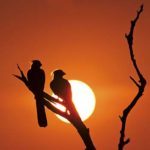 into account its size.
into account its size. - (How) HAHA….I have been asked to provide information on how my photos are taken and I have to say that without a doubt this could be the luckiest and also the most difficult. When I say difficult I don’t mean in the terms of settings but simply what I had to go through in order to get this photo. ISO set to 100 (Remember shooting into the light), Shutter Speed 1/1000 and Aperture set to f5.6. I used my Canon 400mm f5.6 lens combination again but this time used spot metering so that the camera could read the light on the centre point which was the birds themselves.
- As mentioned above, this was probably one of the most difficult photos I have ever had to take and not because of the settings but more to do with the composition side of things. These Grey Go-Away birds had perched themselves on a branch fairly high up and in order for me to get them with the sun behind them I needed to climb up onto the side of the game viewing vehicle, lucky for me I was out on my own and therefore did not look the fool to others. I did however have a good few laughs at myself. I think I must of fallen off at least 5 times before realising that I had to do this another way. I therefore climbed up onto the side of the vehicle, hung on with one hand and using the other picked up my camera, composed the image and took the photo. Sounds all well and easy but you try balancing on one leg, the other counter balancing you. One arm holding on for dear life so that you don’t fall off again this time with camera and lens in hand, compose and take a photo. Laugh I did. A few attempts, I did. Fall, I did but get the photo with the sun and the birds in one, I did. Don’t go falling off mountains or vehicle for that matter but also don’t be lazy. If you have an idea of what you want and you are able to achieve it safely, go for it.
Wise Eye
- (Where) Kruger National Park, South Africa. Far north area of the reserve is an area known as Punda Maria. Very few people travel to this part of the park for a simple reason, the game is few
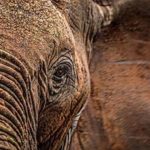 and far between. You need to work hard for your sightings but when you do get a sighting it is normally a good one.
and far between. You need to work hard for your sightings but when you do get a sighting it is normally a good one. - (How) I have always wanted a photo of an elephants eye close up and this is where understanding animal behaviour can help you achieve what you want. Using my 400mm lens so that I could get as close as possible to the eye and setting my camera up, ISO 1000 (early morning and very little light), Sutter Speed to 1/30, actually to slow but with the light conditions the way they were was the best I could push out of my aging camera and lens. Aperture, open to its max, f5.6, also gave me the Depth-Of-Field I wanted.
- Animal behaviour is no more important than with elephants. These animals are enormous and can be very intimidating to the everyday traveller. Getting to know what to look for, the signs of how relaxed they are or if they just not happy with you being in their space. This young bull was right on the side of the road and therefore I approached him slowly to see what his reaction would be to me being so close to him. Once we both where happy, me in the correct position and him eating away on a juicy tree, I was able to setup and take my photo. Never push an animal into a situation they don’t want to be in, you are asking for trouble and if trouble does not arrive you will simply end up chasing the animal away. Both are not going to help you achieve anything photographically.


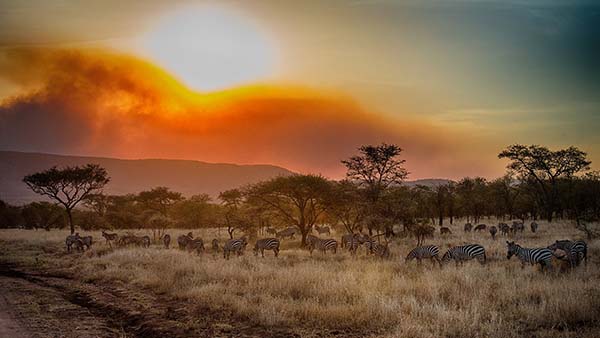 Elke maand nieuws van OOG VOOR AFRIKA ontvangen?
Elke maand nieuws van OOG VOOR AFRIKA ontvangen?